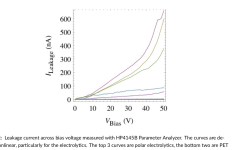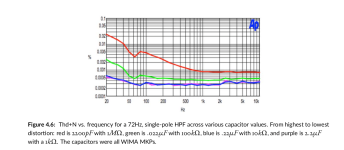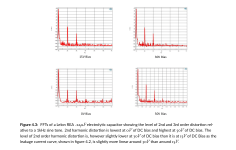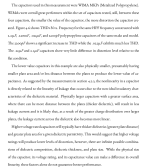caps linearity is on topicsnicoch58 - Linearity is not important for decoupling capacitors.
Ed
Hi nicoch58,
It may be the topic, but it depends entirely on the application. Ed is 100% on the money.
You can not close your eyes and merrily install the "best" capacitor everywhere. There simply isn't a "best" capacitor, and you certainly cannot hear them in every application. The same holds true for resistors and most other components.
It may be the topic, but it depends entirely on the application. Ed is 100% on the money.
You can not close your eyes and merrily install the "best" capacitor everywhere. There simply isn't a "best" capacitor, and you certainly cannot hear them in every application. The same holds true for resistors and most other components.
Please link to a document or post a full document when you post a graph/chart. If that is work you've done, then please post more detail. There's a lot of information and context around your screenshot that would be useful.
A 30 second search leads to work showing that aluminum electrolytic capacitors have higher (relatively speaking) leakage current than some other types of capacitors. Within that document there is also a section devoted to the generalities around leakage current vs. applied voltage. I'm sure that folks willing to spend more than 30 seconds can find more specific information.
tl;dr - your graph lacks a lot of information, and the trend shown in the graph is already known.
https://passive-components.eu/leakage-current-characteristics-of-capacitors/
A 30 second search leads to work showing that aluminum electrolytic capacitors have higher (relatively speaking) leakage current than some other types of capacitors. Within that document there is also a section devoted to the generalities around leakage current vs. applied voltage. I'm sure that folks willing to spend more than 30 seconds can find more specific information.
tl;dr - your graph lacks a lot of information, and the trend shown in the graph is already known.
https://passive-components.eu/leakage-current-characteristics-of-capacitors/
Where is that chart / graph? Please also show the schematic. It might indicate a circuit that is incredibly sensitive to the leakage current. I'd love to see a simple graph of leakage current (nanoAmperes) vs. THD. Obviously the circuit should be something proven and the operating parameters set to norms vs. intentionally creating an edge case. With thanks in advance.sure correlate well with THD measured level
nA compared to the cathode current in a tube isn't that important, and the average DC voltage drop doesn't change much at all (which is the entire point of that capacitor location). Carbon composition resistors have far greater changes, and they are beloved by some tube people.
A good Electrolytic cap will compare favorably to other good Electrolytic types in most parameters. But hey, I guess I don't know. I just use an HP 4192A, 4263A and a Digibridge. Plus earlier analogue types. I've studied components since the late 1970's and serviced equipment longer.
A good Electrolytic cap will compare favorably to other good Electrolytic types in most parameters. But hey, I guess I don't know. I just use an HP 4192A, 4263A and a Digibridge. Plus earlier analogue types. I've studied components since the late 1970's and serviced equipment longer.
that's tell me that you never test 100u pp vs cerafine vs solid polymer ,on cathode sound like night and daycompared to the cathode current in a tube isn't that important
No, they differ in esr, leakage, self inductance, self resonant frequency... and what was told here many times, it depends on the circuit and it's placement within, specs should be chosen accordingly. Ofcourse it will sound different because those mentioned are all different spec (not taking capacitance), and any outside of designed/designated one will sound off. Quite simple as that.
Hello,
Just two ideas regarding caps.
If you have a cathode cap with a voltage of 5 volts present you could use something like a 16 volt dc rated Black Gate cap , or a more common brand name cap with very modest dimensions or you can use something as big as a 0,5 liter coke can. In the past i would surely give the big can a try. But now i would say keeping dimensions like you would expect can't be that bad.
A good friend uses a close to 30 years old Hiraga with caps that were considered amongst the best back then.
After changing the choke in the CLC supply i suggested why not try the Kemet caps from Mouser there should be some progress.
Long story short even after making the change two times and giving time for things to settle. The old ones were a lot better. The original ones appear to have better built quality.The cans use thicker aluminium and had some kind of relief in the shape of the can to obtain a more sturdy can. Back then( and still now) they had co38 and co39 where the last one offered an even longer lifetime than the co38. The co39 offered better sound according to the French. Very probably to obtain longer lifetime quality specs/ control should be better. Nowadays these caps are under Exxelia brand and going through their catalogue they are used in aviation. I remember buying co39 in a surplus store. The reason they popped up there was that the company could not use them anymore because their products would not pass quality control if the caps were produced longer than 3? years ago.
There are companies that require more from their parts than Kemet has to offer.
Visit Exxelia and you will feel the difference.
Greetings, Eduard
P.s back then these caps
were way more expensive than the Kemets from today. Probably the French caps now still are more kind of exclusive
Just two ideas regarding caps.
If you have a cathode cap with a voltage of 5 volts present you could use something like a 16 volt dc rated Black Gate cap , or a more common brand name cap with very modest dimensions or you can use something as big as a 0,5 liter coke can. In the past i would surely give the big can a try. But now i would say keeping dimensions like you would expect can't be that bad.
A good friend uses a close to 30 years old Hiraga with caps that were considered amongst the best back then.
After changing the choke in the CLC supply i suggested why not try the Kemet caps from Mouser there should be some progress.
Long story short even after making the change two times and giving time for things to settle. The old ones were a lot better. The original ones appear to have better built quality.The cans use thicker aluminium and had some kind of relief in the shape of the can to obtain a more sturdy can. Back then( and still now) they had co38 and co39 where the last one offered an even longer lifetime than the co38. The co39 offered better sound according to the French. Very probably to obtain longer lifetime quality specs/ control should be better. Nowadays these caps are under Exxelia brand and going through their catalogue they are used in aviation. I remember buying co39 in a surplus store. The reason they popped up there was that the company could not use them anymore because their products would not pass quality control if the caps were produced longer than 3? years ago.
There are companies that require more from their parts than Kemet has to offer.
Visit Exxelia and you will feel the difference.
Greetings, Eduard
P.s back then these caps
were way more expensive than the Kemets from today. Probably the French caps now still are more kind of exclusive
difference in physical size on mkp
Can you give a reference for this graph? What is the mechanism?
Also don't forget ... what sounds good?
What sounds good is what you are use to hearing. That has no bearing on what actually does sound good. That and friends or people you meet tend to agree with you or the "recognised expert" whether or not what they say is factual.
In my long experience, the best sounding stuff has the lowest distortion and noise when looking at the entire spectrum - as long as there is sufficient power to drive the speakers if we are talking about an amplifier. I hate to say it, but it is really that simple. Folks stuck in the past listening to various tube amps are not listening to the best sound. They are listening to some version they happen to like. I don't have a problem with tone controls, but I do with effects units. If you like a certain thing, that's fine. Just don't even attempt to convince anyone it is the best sound in general. When you have to fall onto the term "sounds musical", well that's a cop out for accepting high distortion or non-linearity. But to bring that to an argument only embarrasses yourself in the eyes of people who actually know.
So. Saying what you prefer is absolutely fine. To attempt to call your view superior over proved metrics is really silly. The vast majority of people clearly prefer the lower distortion causing systems. Decades of observation by industry people prove this. It's also sad that these days the average person hasn't a clue given the amount of misinformation put forward by those with commercial interests. That is the "fashion" part of the audio bushiness.
What sounds good is what you are use to hearing. That has no bearing on what actually does sound good. That and friends or people you meet tend to agree with you or the "recognised expert" whether or not what they say is factual.
In my long experience, the best sounding stuff has the lowest distortion and noise when looking at the entire spectrum - as long as there is sufficient power to drive the speakers if we are talking about an amplifier. I hate to say it, but it is really that simple. Folks stuck in the past listening to various tube amps are not listening to the best sound. They are listening to some version they happen to like. I don't have a problem with tone controls, but I do with effects units. If you like a certain thing, that's fine. Just don't even attempt to convince anyone it is the best sound in general. When you have to fall onto the term "sounds musical", well that's a cop out for accepting high distortion or non-linearity. But to bring that to an argument only embarrasses yourself in the eyes of people who actually know.
So. Saying what you prefer is absolutely fine. To attempt to call your view superior over proved metrics is really silly. The vast majority of people clearly prefer the lower distortion causing systems. Decades of observation by industry people prove this. It's also sad that these days the average person hasn't a clue given the amount of misinformation put forward by those with commercial interests. That is the "fashion" part of the audio bushiness.
I tend to agree, every effort to lower noise and distortion has resulted in a better version of the music than the previous state.
I have read however, that certain extreme low noise amplifiers tend to sound a bit dry, so who knows. I will never own one of those so I’m not really concerned…
My Strickland era dh500 sounds better than nearly any previous version that I have heard and was only improved by replacing the smaller electrolytic parts on the rails using parts that are known to have less distortion than typical general use parts.
I have read however, that certain extreme low noise amplifiers tend to sound a bit dry, so who knows. I will never own one of those so I’m not really concerned…
My Strickland era dh500 sounds better than nearly any previous version that I have heard and was only improved by replacing the smaller electrolytic parts on the rails using parts that are known to have less distortion than typical general use parts.
Hi phase,
I have not heard a dry sounding amplifier with true low distortion. That is probably low level high frequency distortion or noise.
On your amp, try matching Q3, Q4 and Q5, Q6 very tightly and with close beta to each pair. Same for Q7 and Q10 and Q11 (complimentary). The Beta matching jig I gave to everyone will get you matches closer than monolithic pairs types often. These are really nice sounding amplifiers. The detail work I just mentioned will lower distortion and you can hear it. Your DC offset will also probably be less than 5 mV if done right. The other caps are HF compensation caps and filters. Polystyrene and polypropylene types depending on value. C0G/NP0 ceramics are as good, and some good mica types. Up the wattage rating on R25 and go for low TC Metal Film types for that and R26.
-Chris
I have not heard a dry sounding amplifier with true low distortion. That is probably low level high frequency distortion or noise.
On your amp, try matching Q3, Q4 and Q5, Q6 very tightly and with close beta to each pair. Same for Q7 and Q10 and Q11 (complimentary). The Beta matching jig I gave to everyone will get you matches closer than monolithic pairs types often. These are really nice sounding amplifiers. The detail work I just mentioned will lower distortion and you can hear it. Your DC offset will also probably be less than 5 mV if done right. The other caps are HF compensation caps and filters. Polystyrene and polypropylene types depending on value. C0G/NP0 ceramics are as good, and some good mica types. Up the wattage rating on R25 and go for low TC Metal Film types for that and R26.
-Chris
Sounds good, I would check the match nonetheless. Your pairs can be not matched, but the way they come together can by fluke give low DC offset. The diff pair is critical for lowering distortion. Reducing the distortion in following stages reduces the work the diff pair has to do, so it sounds better.
Try my suggestions with one amp. ALso pay attention to the gain setting resistors as I mentioned. Coupling caps don't matter as much as people think once you hit a decent quality level. It's the other small value capacitors that will make a difference. Trust me on that.
Try my suggestions with one amp. ALso pay attention to the gain setting resistors as I mentioned. Coupling caps don't matter as much as people think once you hit a decent quality level. It's the other small value capacitors that will make a difference. Trust me on that.
I remember them well. They did have an interesing set of indentatios on the can. Very sturdy build. Were they SIC-SAFCO?good friend uses a close to 30 years old Hiraga with caps that were considered amongst the best back then.
Hello,
If i am remember right they were branded Novea.
Could have been a division of Sic safco which were sold too at Rue de Belfort in Paris. Most of the time they were out of stock. I think now it is Exxelia brandname. Very few caps are build with this level of attention. Compared to the usual brands they are in a different League.
Most audiophiles will stick with the usual stuff. Back then even with the 20 watt most money would be in the power supply.
Greetings Eduard
If i am remember right they were branded Novea.
Could have been a division of Sic safco which were sold too at Rue de Belfort in Paris. Most of the time they were out of stock. I think now it is Exxelia brandname. Very few caps are build with this level of attention. Compared to the usual brands they are in a different League.
Most audiophiles will stick with the usual stuff. Back then even with the 20 watt most money would be in the power supply.
Greetings Eduard
- Home
- Design & Build
- Parts
- Best electrolytic capacitors



